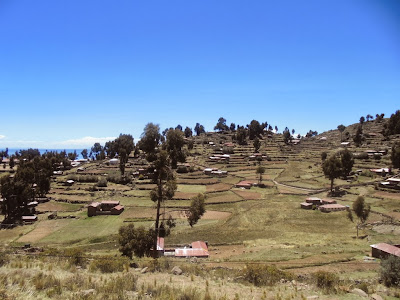It took us about an hour and a half
from Amantaní
to reach the island of Taquile, the last stop on our way. After a
brief storm during the night the sky was again of the deepest blue,
and despite the altitude of 3,800m it was quite hot. Sunscreen, hat
and sunglasses are a must; the sun is very intense and sunburn
happens quickly.
Here,
Pepe sent us off along a stone-paved path: we were going to meet at
the central plaza about an hour later. It was a pleasant walk through
a landscape that seemed almost mediterranean, the terrassed hills
sloping down to the narrow shore, the aquamarine water of the lake
sparkling in the sunshine. Here, too, the Inca had grown crops and
raised animals, as their descendants were doing now. It is fairly
dry, since the rainy season hasn't really begun yet.
We strolled
leisurely in little groups and arrived at the plaza at 10:30. The
most important buildings of the village were assembled around the
plaza: the catholic church, the school, the community centre, and the
knitters cooperative. Taquile is famous for its beautiful textiles,
and the men are actively involved in the production.
Children in
traditional dress were setting up displays of their school work: it's
the end of the school year and obviously it was time to show parents
and relatives examples of their school work.
We
gathered around Pepe who now told us about the people of Taquile. A
unique society developed and still thrives here, with not only its
own customs but its own laws as well. I had noticed how different the
dresses were from the ones worn on Amantaní,
and now we heard that the interesting hats worn by the men are not
only a means of differentiating the islanders from others, but also
have meaning in their own society.
When
the children are still small, until about the age of six or seven,
their long toques are mainly of light colouring. At the age of ten or
eleven they are starting to wear hats with bright colours (mostly
some shade of red), the tapered long 'tail', still white or at least
light in colour, worn on their backs. A little later yet, at the age
of twelve, the long tip is worn on the side, the pompom either on
the left or the right side of the face, like a single braid might be
worn by a woman. This indicates that they are reaching puberty and
are now allowed to look for a girlfriend.
Boys
keep wearing this bi-coloured head covering, and everybody in the
community knows that they are 'available'. Once they have found a
girlfriend the long tip is gathered up in a kind of knot. They will
live with the girlfriend, with the blessing of the parents, for up to
two or three years to see if the relationship is truly a fit. If it
isn't, and the couple doesn't have a baby yet, they can separate
again without a problem. The young man can then look for another
girlfriend, and the same procedure is repeated. This second
'try-out', however, is the last one that's sanctioned: if he
separates from his girl again he is considered to be not trustworthy,
and girls (and their parents) will hesitate to engage with him.
Only
when a relationship is truly secure the 'real' marriage will take
place in the catholic church. Once again this change of status is
indicated by a change in the colour of the hat, which will be red
from now on. This, Pepe said, is when it becomes serious; there is no
turning back. The beautifully woven red hats are gifts from the
chosen women – or rather, the women choose their husbands by
knitting the hat for their man, rolling it up tightly, and secretly
handing it to him, thus affirming their choice of husband.
Since
the textile industry is the mainstay of the Taquile islanders,
knitting is taught from a very early age on and is the most important
part of the curriculum throughout elementary and high school.
The
most skilled knitters are the most desirable bachelors: the better a
knitter a boy is, the better his chances of being successful in life.It's
amazing that this society has survived and is thriving like this.
After
this interesting explanation we made our way to the top of the
island where we were served a delicious lunch of fresh lake trout,
rice and vegetables, accompanied by the ever popular muña
tea.
We had an amazing view of the lake which stayed with us all the way
down the long set of stone stairs to the wharf where our boat – 'the best boat in Puno',
according to Pepe – was waiting to take us back.
It
felt as if we had been away for much longer than a day and a half,
and I'm sure we all will carry the impressions from this journey into
a totally different world with us for a long time.





No comments:
Post a Comment